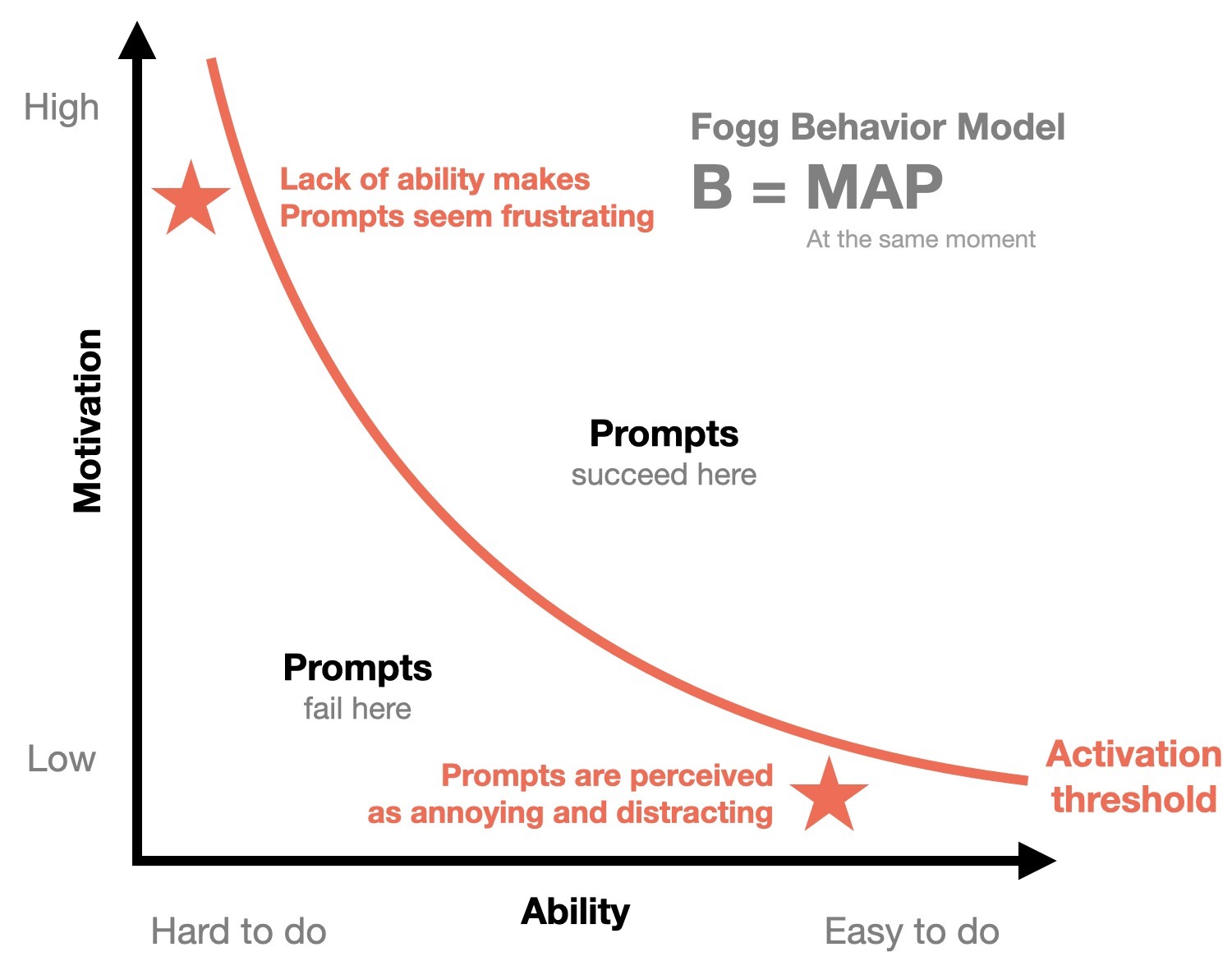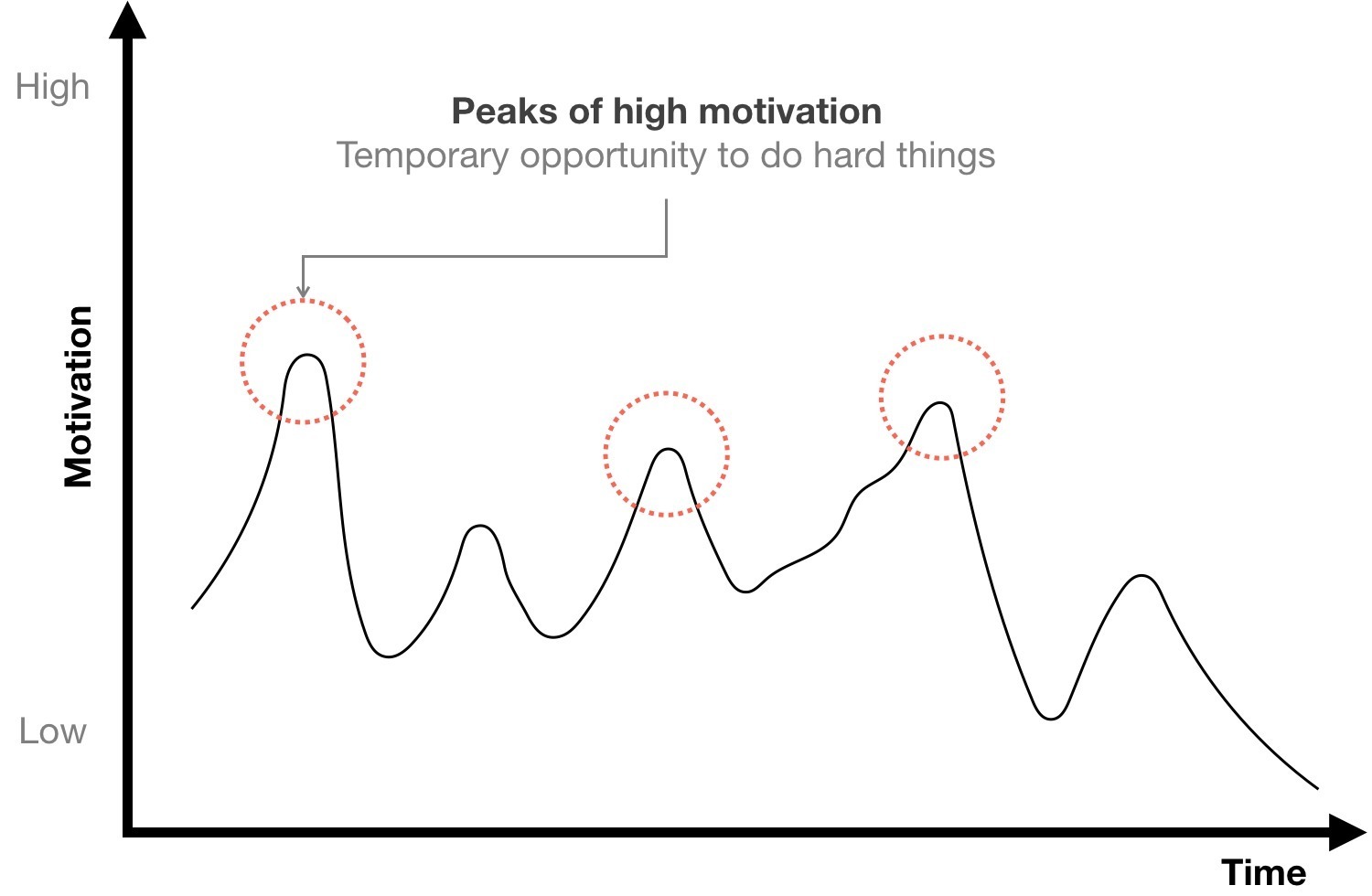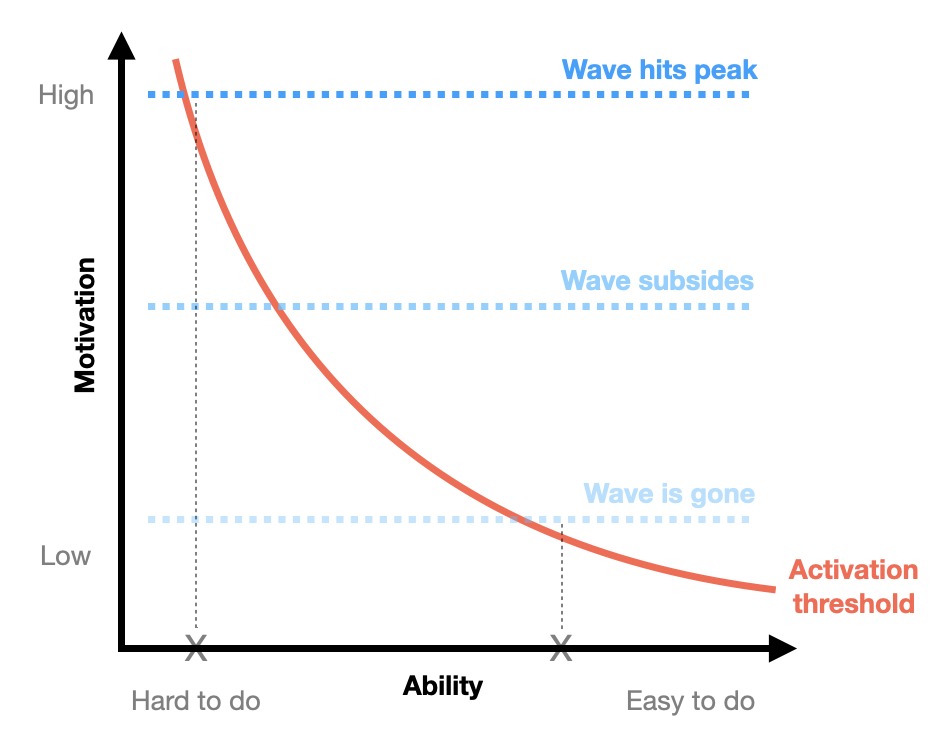As designers, our ultimate goal is to create designs that motivate users to take action. But what drives user behavior? And how can we design products that encourage users to take the desired action?
BJ Foggs Behavior Model
One framework that helps us answer these questions is BJ Fogg’s behavior model, known as B=MAP. According to this model, behavior is the result of three factors: motivation, ability, and prompt. In other words, people are more likely to engage in a behavior when they are motivated, have the ability to perform the behavior, and are prompted to do so.

The Fogg Behavior Model
Behavior (B)
This is the action or behavior that we want our users to take. It could be anything from making a purchase to signing up for a newsletter. The key is to identify a specific behavior that we want to target. For example, if you’re designing an e-commerce website, the behavior you want to target might be completing a purchase.
Motivation (M)
Looking at getting a behavior to happen, the first component of the behavior model is motivation, which refers to the desire or willingness to perform a behavior. Persuasive patterns such as Scarcity, Need for Closure, and Delighters can be effective in increasing motivation. Scarcity creates a sense of urgency by emphasizing limited availability or time-sensitive offers. Need for Closure appeals to our innate desire for certainty and closure, and Delighters provide unexpected and enjoyable surprises that can motivate users to engage with a product or service.
Ability (A)
The second component of the behavior model is ability, which refers to the ease or difficulty of performing a behavior. Persuasive patterns such as Sequencing and Tailoring can be effective in increasing ability. Sequencing breaks down complex tasks into smaller, manageable steps. Tailoring involves personalizing the experience to match the user’s needs and preferences – in turn decreasing the mental energy needed to perform a desired behavior.
Prompt (P)
The third component of the behavior model is prompt, which refers to a trigger or cue that initiates a behavior. Persuasive patterns such as Triggers, Anchoring, and Feedback Loops can be effective in providing prompts. Triggers can be external (e.g. notifications or reminders) or internal (e.g. a change in mood or mindset), while Anchoring associates a behavior with a specific context or cue. Feedback Loops provide real-time feedback on a user’s progress or performance, which can encourage continued engagement and behavior change.
Let’s take an example of how these persuasive patterns can be applied in design:
Imagine you’re designing a fitness app that encourages users to exercise regularly. You can use Scarcity by offering a limited-time discount on premium features for users who complete a certain number of workouts per week. Need for Closure can be addressed by providing a clear and structured workout plan that users can follow, while Achievements can be included by rewarding users with badges or virtual trophies for reaching certain milestones.
Increasing users’ ability rather than reducing the effort
Rather than trying to increase the ability users, you’re in most cases better off decreasing the amount of ability needed to perform a desired behavior – i.e. reducing the effort needed to perform the behavior. Focus on designing clean and intuitive user interfaces, easy to navigate. Sequencing can be applied by breaking down workouts into smaller, more manageable sets of exercises. Tailoring can be achieved by allowing users to customize their workout plan based on their fitness level, goals, and preferences.
Finally, to prompt users to engage with the app regularly, you can use Triggers by sending push notifications reminding them of their upcoming workouts. Anchoring can be used by associating certain types of workouts with specific locations or times of day. Feedback Loops can be included by providing real-time feedback on a user’s progress and offering suggestions for improvement.
Motivational Waves
But what motivates people to take action? One concept that can help us answer this question is the idea of motivational waves. Motivational waves refer to the ebb and flow of motivation that people experience throughout the day. When motivation is high, people are more likely to engage in behaviors that require effort or attention. When motivation is low, people are more likely to engage in behaviors that are easy or require little effort.

Motivatinal Waves - a concept by BJ Fogg
The concept of motivational waves explains that motivation is not a constant state, but rather it comes and goes in waves.
In order to design for behavior change, Fogg suggests that designers should focus on designing for moments of high motivation, or “hot triggers”, that coincide with these waves of motivation. By understanding when people are most likely to be motivated to take action, designers can create experiences that make it easy for them to do so.

The motivational wave comes and goes. At its peak, motivation is highest, but soon the wave subsides until it's gone.
Motivational waves are not only influenced by internal factors such as emotions and physical sensations, but also external factors such as social influence and context. For example, a person may be more motivated to exercise when they are in a group setting with others who are also exercising, even if they don’t feel particularly motivated on their own.
As an example the Appointment Dynamics can create a sense of urgency and motivation by setting a specific time for the user to complete a task. The Fresh Start Effect can tap into a person’s motivation during times of new beginnings, such as the start of a new year, to encourage behavior change.
Applying motivational waves and the behavior model
Applying the two concepts of motivational waves and BJ Fogg’s behavior model to design is easier said than done. One thing is learning about all the psychological intricacies of the human mind, another is having that knowledge as a starting point as a team – having a shared vocabulary.
One tool that can help is the Persuasive Patterns card deck.
The Persuasive Patterns card deck is a collection of 60 bite-sized insights into the human mind, each designed to help designers create products that encourage users to take action. Each card covers a specific persuasive pattern, such as social proof, scarcity, or framing, and provides examples of how the pattern can be applied in design.
For example, let’s say you’re designing a mobile app to encourage people to exercise more. You could use the chunking pattern, which involves breaking down a task into smaller, more manageable chunks. In this case, you could break down a workout into a series of smaller exercises or routines, making it easier for users to get started and stay motivated.
Another example is the reward pattern, which involves providing users with a sense of accomplishment or satisfaction for completing a behavior. In the context of a fitness app, you could reward users for completing a certain number of workouts or achieving a specific fitness goal.
By incorporating persuasive patterns into your UX strategy, you can design products that align with the motivational waves of your users, making it more likely that they will engage in the desired behavior. Additionally, by focusing on the ability and prompt factors of BJ Fogg’s behavior model, you can create products that are easy to use and provide clear cues for action.
Understanding the factors that drive behavior and leveraging persuasive patterns can help designers create products that motivate users to take action. The Persuasive Patterns card deck is a powerful tool for incorporating these concepts into your UX strategy, and can help you design products that truly make a difference in the lives of your users.
Sources
1 Fogg Behavior Model by BJ Fogg
2 Motivational Waves by BJ Fogg